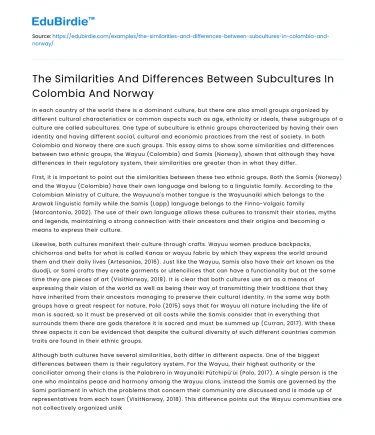In each country of the world there is a dominant culture, but there are also small groups organized by different cultural characteristics or common aspects such as age, ethnicity or ideals, these subgroups of a culture are called subcultures. One type of subculture is ethnic groups characterized by having their own identity and having different social, cultural and economic practices from the rest of society. In both Colombia and Norway there are such groups. This essay aims to show some similarities and differences between two ethnic groups, the Wayuu (Colombia) and Samis (Norway), shown that although they have differences in their regulatory system, their similarities are greater than in what they differ.
First, it is important to point out the similarities between these two ethnic groups. Both the Samis (Norway) and the Wayuu (Colombia) have their own language and belong to a linguistic family. According to the Colombian Ministry of Culture, the Wayuuna's mother tongue is the Wayuunaiki which belongs to the Arawak linguistic family while the Samis (Lapp) language belongs to the Finno-Volgaic family (Marcantonio, 2002). The use of their own language allows these cultures to transmit their stories, myths and legends, maintaining a strong connection with their ancestors and their origins and becoming a means to express their culture.
Save your time!
We can take care of your essay
- Proper editing and formatting
- Free revision, title page, and bibliography
- Flexible prices and money-back guarantee
Likewise, both cultures manifest their culture through crafts. Wayuu women produce backpacks, chichorros and belts for what is called Kanas or wayuu fabric by which they express the world around them and their daily lives (Artesanias, 2016). Just like the Wayuu, Samis also have their art known as the duodji, or Sami crafts they create garments or ultencilices that can have a functionality but at the same time they are pieces of art (VisitNorway, 2018). It is clear that both cultures use art as a means of expressing their vision of the world as well as being their way of transmitting their traditions that they have inherited from their ancestors managing to preserve their cultural identity. In the same way both groups have a great respect for nature, Polo (2015) says that for Wayuu all nature including the life of man is sacred, so it must be preserved at all costs while the Samis consider that in everything that surrounds them there are gods therefore it is sacred and must be summed up (Curran, 2017). With these three aspects it can be evidenced that despite the cultural diversity of such different countries common traits are found in their ethnic groups.
Although both cultures have several similarities, both differ in different aspects. One of the biggest differences between them is their regulatory system. For the Wayuu, their highest authority or the conciliator among their clans is the Palabrero in Wayunaiki Pütchipü’üi (Polo, 2017). A single person is the one who maintains peace and harmony among the Wayuu clans, instead the Samis are governed by the Sami parliament in which the problems that concern their community are discussed and is made up of representatives from each town (VisitNorway, 2018). This difference points out the Wayuu communities are not collectively organized unlike the Samis who work together so it can cause a clash between these cultures.
To conclude, detailing specific aspects of cultures reflects certain differences in their system of norms and it is clear that the similarities are greater. Despite being a culture from such different countries, they retain their roots and express their culture in their own way. Having a language, an art of its own and the same conception of the world and nature makes them two similar cultures. There may be large differences in the dominant culture of Colombia and Norway, but in the minorities may be key in a cultural approach by achieving mutual understanding and respect for diversity.






 Stuck on your essay?
Stuck on your essay?

